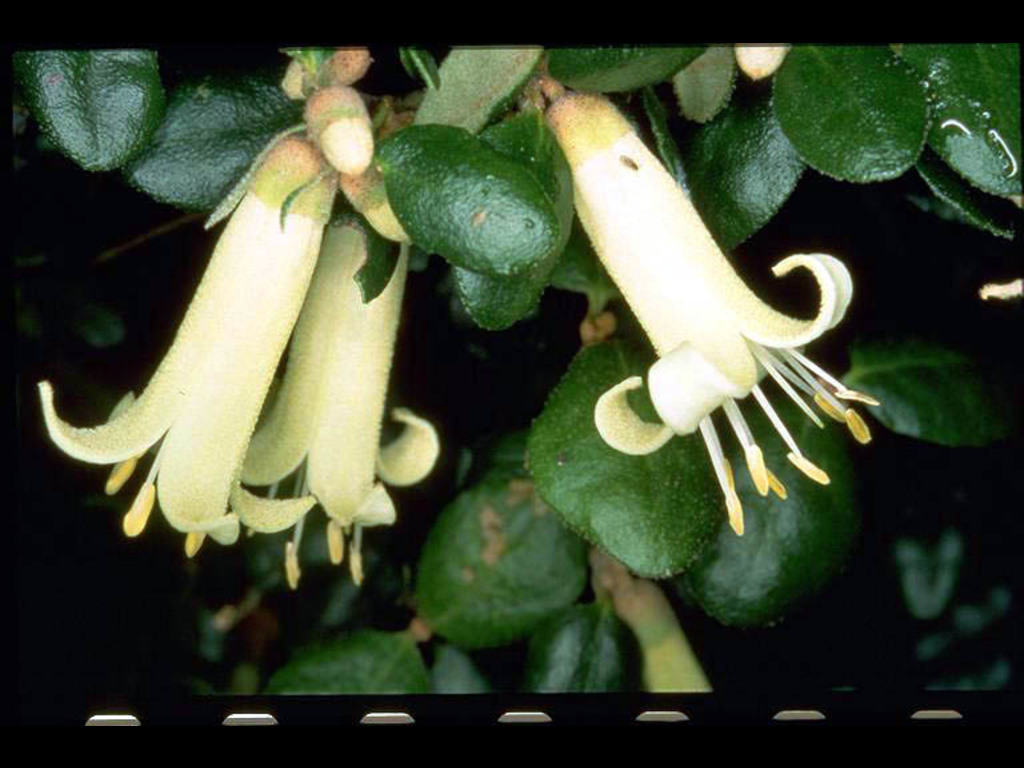Correa 'Ivory Dancer'
- File Number
- 712
- ACRA Field Book Number
- 732
- Registration Date
- 26/04/2001
- Application Received
- 17/06/1999
- Family
- Rutaceae
- Cultivar Name
- Correa 'Ivory Dancer'
- Origin
- Correa 'Ivory Dancer' thought to be a hybrid between Correa reflexa and Correa pulchella. The name refers to the colour and character of the flowers. It was first selected in 1990 from a plant found growing (introduced) at Points Arboretum, Colerain, Victoria. The origin is unknown but is assumed to be South Australia..
- Characteristics
- Vigorous shrub to c. 1.5 m x 2 m with a dense habit. Branchlets sparsely tomentose with rust coloured stellate hairs. Simple elliptical leaves, 23 mm x 16 mm, petioles to 0.5 mm. Leaf apices obtuse, leaf bases oblique, venation reticulate, margins entire, lamina curves into convex shape. Upper surfaces of mature leaves dark green and glabrous to scabridulous with occasional stellate hairs. Upper surfaces of young leaves sparsely tomentose with white stellate hairs and occasional rust-coloured stellate hairs. Lower surfaces tomentose with minute white stellate hairs and scattered rust-coloured stellate hairs becoming more concentrated on the veins. Calyx tomentose with rust coloured stellate hairs, pedicels to 4 mm. Corolla cylindrical 23 mm x 8 mm, ivory-white, petals strongly reflexed (spreading lobes). Anthers exerted, narrow oblong, obtuse. Peak flowering is from April to August in most districts. Diagnosis: The leaves of this cultivar conform to descriptions for C. reflexa var. reflexa, except for the oblique bases and petioles to 5 mm which conforms to C. pulchella. The flower has an affinity to C. pulchella because of its spreading lobes and single colour. It is a taller shrub than the range (1 m) given for C. pulchella by Wilson (1998). The cultivar is distinctive because of its white flower colour which is different from other C. reflexa x C. pulchella hybrids such as C. 'Dusky Bells', C. 'Pink Mist' and C. 'Mannii'. The cultivar varies from C. 'Ivory Bells' in parentage (C. alba var. alba x C. backhouseana) and in leaf size.
- Cultivation
- This cultivar is frost and drought hardy and has a dense growth habit. The white flowers with recurved tips, which appear in autumn, are an attractive feature of the plant. It is easy to grow from cuttings and is bird attractive as well as being pest-free. This form would be suited to most garden conditions. It responds favourably to light pruning. It would suit tub planting and foreground planting in garden beds.
- Publication
- Hitchcock, M. (2003), Descriptions of the Species, Varieties and Cultivars. Australian Plants 22(174): 35
- Colour Coding
- RHS Colour Chart 1995Corolla tube: 150DLeaf upper surface: close to 137ALeaf lower surface: close to 193A
- Propagation
- Cuttings from semi-firm new growth
- Applicant Name
- Cherree Densley on behalfof the ASGAP Correa Study Group. Specimen first received by the Authority17/6/1999.
- Uses
- As part of a mass planting or mixed in a shrubbery, or as a feature plant. Attracts nectar feeding birds.
- Availability
- Specialist native plant nurseries
- ANBG Accession Numbers
- ACC712, ACRA732, CBG9914013
- NSL ID
- -

